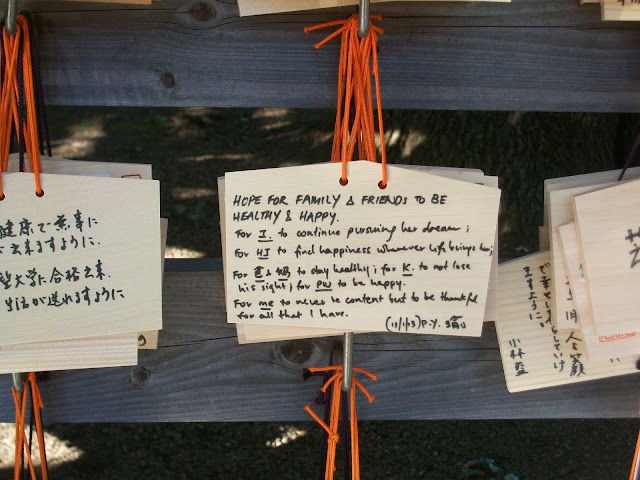Just last week I visited the Meiji Shrine, the largest in Japan. It is located in a forest that covers an area of 700,000 square-meters (about 175 acres) in downtown Tokyo. (It reminded me very much of the similar choice property Central Park takes up in the middle of downtown New York City!) This area is covered by an evergreen forest that consists of 120,000 trees of 365 different species, which were donated by people from all parts of Japan when the shrine was established. The forest is visited by many as a recreation and relaxation area in the center of Tokyo.
After the emperor's death in 1912 (Hiro Hito's father), the Japanese Diet passed a resolution to commemorate his role in the Meiji Restoration.
An iris garden in an area of Tokyo where Emperor Meiji and Empress
Shōken had been known to visit was chosen as the building's location.
Construction began in 1915, and the shrine was built in the traditional nagare-zukuri
style and is made up primarily of Japanese cypress and copper. It was
formally dedicated in 1920, completed in 1921, and its grounds
officially finished by 1926. Until 1946, the Meiji Shrine was officially designated one of the Kanpei-taisha (官幣大社), meaning that it stood in the first rank of government supported shrines.
The original building was destroyed during the Tokyo air raids of World War II. The present iteration of the shrine was funded through a public fund raising effort and completed in October, 1958.
The Meiji Shrine was brought into the flow of current events with the 2009 visit of United States Secretary of State Hillary Clinton. After arriving in Tokyo on her first foreign trip representing the newly elected President Barack Obama,
she made her way to this shrine in advance of meetings with Japan's
leaders to show her "respect toward history and the culture of Japan."
In January 2010, German Foreign Minister Guido Westerwelle demonstrated the same respect when he concluded his visit to Japan with a visit of the shrine.[7]
As is typical with all shrines, a torii marks the entrance. This one, however, was not the usual wood painted red. Instead, the two vertical wooden posts were two very large, natural, impressive tree trunks!
Typical short-skirted Japanese patron

Hundreds of barrells of sake lined a portion of the walkway.
And here the walkway was lined with paper lanterns and a second torii.
After about a half-mile walk, I saw a third torii prior to entering the gate in front of the shrine.
Hmm! Same short skirt ahead of me approaching the gate
Sometimes the gates can be almost as impressive as the shrine! I learned that those two scary wooden guards seen posed on either side of the other gates are only in gates leading to temples, not shrines.

Here, the people are approaching the shrine where they will bow, pray, and toss money into receptacles.

Awesome Taiko drum inside the shrine
The courtyard in front of the shrine had buildings on both sides.
Lots of businessmen were there that day...
...as well as monks
I soooo need to find out what is meant by these folded strips of paper!
We started noticing these around the time of New Years celebrations.
This shot is taken from the shrine steps looking back towards the gate.
See what I mean by the gates being almost as awesome!
It is customary to write prayers or wishes on blank wooden tablets purchased on the grounds.
They are then displayed for all to see.
Everyone seemed to be participating.
And yes, there were some even in English!
Here the walkway is lined with hundreds of barrels of wine presented to Japan from Bourgogne, France.
Just outside the shrine is a popular Tokyo landmark.
Of course, we Americans refer to it as the Empire State Building!






















So cool. Did you have to do the cleansing? I love the lanterns.
ReplyDeleteyes, i wondered the same thing as erin. everything is just cool. i love the decorations of japan.
ReplyDelete